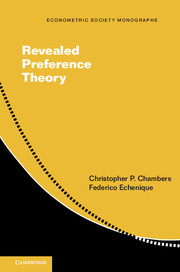Book contents
- Frontmatter
- Dedication
- Contents
- Preface
- 1 Mathematical Preliminaries
- 2 Classical Abstract Choice Theory
- 3 Rational Demand
- 4 Topics in Rational Demand
- 5 Practical Issues in Revealed Preference Analysis
- 6 Production
- 7 Stochastic Choice
- 8 Choice Under Uncertainty
- 9 General Equilibrium Theory
- 10 Game Theory
- 11 Social Choice and Political Science
- 12 Revealed Preference and Systems of Polynomial Inequalities
- 13 Revealed Preference and Model Theory
- References
- Index
- Miscellaneous Endmatter
2 - Classical Abstract Choice Theory
Published online by Cambridge University Press: 05 January 2016
- Frontmatter
- Dedication
- Contents
- Preface
- 1 Mathematical Preliminaries
- 2 Classical Abstract Choice Theory
- 3 Rational Demand
- 4 Topics in Rational Demand
- 5 Practical Issues in Revealed Preference Analysis
- 6 Production
- 7 Stochastic Choice
- 8 Choice Under Uncertainty
- 9 General Equilibrium Theory
- 10 Game Theory
- 11 Social Choice and Political Science
- 12 Revealed Preference and Systems of Polynomial Inequalities
- 13 Revealed Preference and Model Theory
- References
- Index
- Miscellaneous Endmatter
Summary
We start our development of revealed preference theory by discussing the abstract model of choice. All revealed preference problems have two components: data, and theory. Given a family of possible data, and a particular theory, a revealed preference exercise seeks to describe the particular instances of data that are compatible with the theory. We shall illustrate the role of each component for the case of abstract choice. The data consist of observed choices made by an economic agent. A theory describes a criterion, or a mechanism, for making choices.
Given is a set X of objects that can possibly be chosen. In principle, X can be anything; we do not place any structure on X. A collection of subsets ∑ ⊆ 2X\﹛∅﹜ is given, called the budget sets. Budget sets are potential sets of elements from which an economic agent might choose. A choice function is a mapping c : ∑→2X\﹛∅﹜ such that for all B ∈∑, c(B)⊆B. Importantly, choice from each budget is nonempty.
For the present chapter, choice functions are going to be our notion of data. The interpretation of a choice function c is that we have access to the choices made by an individual agent when facing different sets of feasible alternatives. A particular choice function, then, embodies multiple observations.
The main theory is that of the maximization of some binary relation on X. The theory postulates that the agent makes choices that are “better” than other feasible choices, where the notion of better is captured by a binary relation. The theory will be refined by imposing assumptions on the binary relation: for example that the relation is a preference relation (i.e. a weak order).
Given notions of data and theory, the problem is to understand when the former are consistent with the latter. We are mainly going to explore two ways of formulating this notion of consistency.
- Type
- Chapter
- Information
- Revealed Preference Theory , pp. 15 - 33Publisher: Cambridge University PressPrint publication year: 2016



